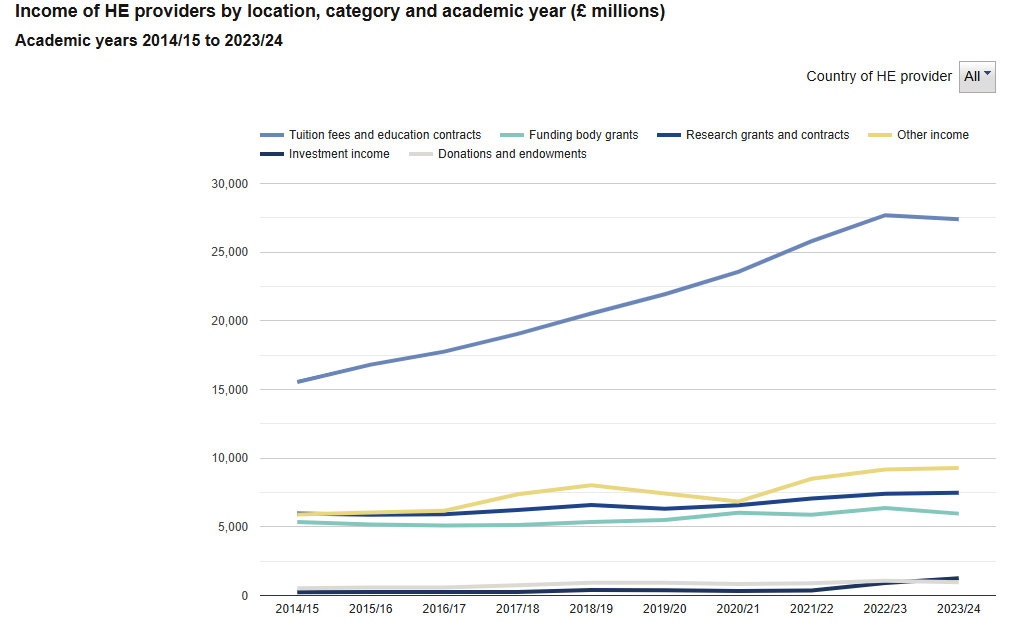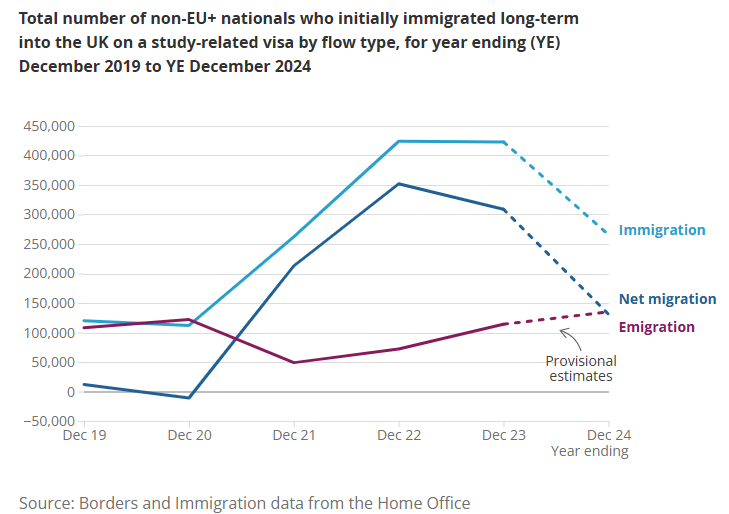Author
Rebecca Robinson
Data Analyst (Higher Education Insight), QAA
Data releases
HESA 2023-24 finance data
HESA released data in May on finance of higher education providers for 2023-24. In a change to the usual trend, tuition fees and education contracts – which make up the biggest share of income – were down from £27,689 million to £27,391 million. In terms of expenditure, for the first time other operating expenses (£20,148 million) were higher than staff costs (£18,399 million). Wonkhe provided a useful summary of the data.

Data taken from HESA (https://www.hesa.ac.uk), licensed under CC BY 4.0.
College staffing data for Scotland
The latest data on staffing in colleges in Scotland released by SFC (Scottish Funding Council) shows there were 10,112 FTE staff employed in colleges in 2023-24, down by 7.7% (875 FTE) from the previous year. Headcount was down from 14,147 in 2022-23 to 13,092 in 2023-24, a reduction of 7.5%.
Key stage 4 destination measures
The DfE (Department for Education) released data in May on the destinations of English pupils who left key stage 4 study in 2021-22. 93.2% of students were in a sustained (ie for at least 6 months) education, apprenticeship or employment destination, slightly down on the previous year (by 0.7ppts). 86% of pupils were in sustained education, 3.2% were in an apprenticeship destination and 4% were in an employment destination.
Disadvantaged pupils (defined as those that had been eligible for free school meals at any point in the previous 6 years, had been looked after by the local authority or had been adopted from care) were less likely to have a sustained destination than other pupils (86.2% compared to 95.6%). There are also regional differences, with pupils from London most likely to have an overall sustained destination (94.6%) and pupils from the North East the least likely (91.5%).
Young people not in education, employment or training
ONS (Office for National Statistics) released estimates for January to March 2025 of young people (16-24 years old) not in education, employment or training (NEET). An estimated 12.5% of all young people in the UK were NEET in January to March 2025 (923,000) – down 0.3ppts compared to the same period in 2024 and 0.9ppts on the previous quarter.
Higher level apprenticeships in Northern Ireland
DfENI’s (Department for the Economy in Northern Ireland) latest report on higher level apprenticeships (HLA) in higher education for 2022-23 (level 6 and 7) shows there were 300 HLA starts in 2022-23, an 11% increase compared to 2021-22, and 780 HLA students in total, up 20% on 2021-22. More males joined an HLA programme than females (185 and 115 respectively) and business and management was the most popular subject area.
International students update
It’s been a big month for data relating to migration. Monthly figures for sponsored study visa main applications continue to recover, with the figure for April 2025 (14,800) up compared to April 2024 (9,600).
Also released in May was data from the ONS on a longer term look at international student migration. Around 1/3 of non-EU nationals (35%) who immigrated in year ending (YE) December 2024 were on a study related visa (either study visa or study-dependant visa).
The report shows that immigration on study related visas was down for YE December 2024 while emigration was up and so net migration for the period was down.

Data taken from The National Archives (https://www.nationalarchives.gov.uk), licensed under Open Government Licence v3.0.
The report also found that more non-EU nationals who arrived on study related visas are remaining in the UK and transitioning to other visa types rather than emigrating after their studies end. The top nationalities arriving in the UK (YE December 2023) on a study visa were Indian (103,000), Nigerian (39,000) and Chinese (53,000). Proportions transitioning to a non-study visa after three years in the UK varies by nationality – for YE December 2021 arrivals, 80% of Nigerian nationals had transitioned to non-study visas after three years compared to 64% of Indian nationals and 14% of Chinese nationals.
Also in May, the Migration Advisory Committee published an update to its net migration report from 2023. The report covers all types of migration, not just in relation to study, and covers in detail the impacts of different types of migration and how policy changes can affect them.
Analysis in the sector
Financial sustainability
Medr, the OfS (Office for Students) and SFC have all released analysis of sector finances for their respective constituencies this month.
The Welsh tertiary education regulator, Medr, published its analysis of the 2023-24 HESA finance data focusing on Welsh higher education institutions (HEIs). Total income of Welsh HEIs in 2023-24 was £1.98bn, the same as in 2022-23. Just over half of income came from tuition fee and education contracts (56%). Total underlying expenditure was £2.04bn, 4% up on the previous year (£1.96bn). The underlying operating position of Welsh HEIs was a deficit of £61 million, a decline from a surplus of £21 million in 2022-23.
The annual OfS financial sustainability report, based on audited finance data and provider forecasts, shows 43% of the institutions analysed are forecasting a deficit for 2024-25. The report suggests that further deterioration will probably continue as aggregate forecasts for growth in student numbers are felt by the OfS to be over-optimistic (26% growth in UK entrants and 19.5% in international entrants between 2023-24 and 2027-28). Reported UK student recruitment in 2023-24 was 10.8% below institution forecasts and international recruitment was 15.5% below.
The report acknowledges that many providers are taking steps to address financial risks and have ongoing cost reduction programmes. Recently released Universities UK (UUK) survey data corroborates this, revealing that 49% of providers surveyed have closed courses, 46% have removed module options and 18% have closed departments.
Interim analysis of financial sustainability of both colleges and universities in Scotland was released this month (with a full report due in September). The analysis excludes the University of Dundee and a number of colleges that have not yet submitted annual accounts.
The report found that colleges reported an operating surplus of £570,000 in 2023-24, a substantial improvement on the deficit of £14.4 million from 2022-23. The improvement is attributable to reductions in staff costs. 76% of the total income for the college sector was from the SFC grant.
Universities reported a surplus of £17.2 million for 2023-24, a deterioration from the surplus of £211.7 million in 2022-23 (though better than the forecast of £7.4 million deficit). Dependency on SFC grants was reduced to 24% of income.
SFC analysis of completion and retention by characteristic
The SFC Mainstreaming and Equality Outcome Report 2025-29 released in May includes statistics split by demographic groups for both the college and university sectors. The report shows that care experienced students have the lowest successful completion rates across both FE and HE courses in colleges. Data on retention between first and second year at Scottish universities shows care experienced, male, mature and students whose gender identity is other all below the sector average retention rate.
Social mobility and cold spots
The Sutton Trust has published an Opportunity Index report examining how social mobility in England differs by parliamentary constituency. The index uses data from the National Pupil Database and the Longitudinal Education Outcomes dataset (LEO) and uses indicators including GCSE and A level results, proportion with a degree by age 22 and earnings data. The report shows that the 20 constituencies with the highest ranking for opportunity are all in London. The highest ranked area outside London is Birmingham Perry Bar (in 23rd). The lowest ranked constituency overall is Newcastle upon Tyne Central and West.
Following up from its introductory paper on widening participation published last month, UPP Foundation has now published a report into ‘cold spots’ for widening participation in higher education. The report covers an in-depth qualitative investigation focused on Doncaster and finds that university seems like a ‘bad bet’ in cold spots because of the cost and debt involved combined with the ‘payoff’ of a degree seeming minimal for those that want to stay local. It noted that cold spots can remain cold because of a lack of local graduate job opportunities and that community and family can drive behaviour of young people, rather than economic opportunities. The report also noted that schools, colleges and universities in cold spots can struggle to support young people in making informed, confident decisions.
Also released this month was a report from the Ruskin Institute for Social Equity (RISE) highlighting lower participation rates for pupils from free school meal backgrounds in coastal and rural communities.
Nurse Educator Workforce in Higher Education in England
The Royal College of Nursing published a report this month on the nurse educator workforce in England. Key findings were that increases in the academic nurse educator workforce were uneven and inconsistent across regions, and reactive rather than planned. The report also found that nearly half the nurse educator workforce is nearing retirement and that the educator workforce is not representative of the wider workforce or of students.
Using earnings data in HE regulation
The Institute for Fiscal Studies has published a report exploring options for an earnings based outcome measure that could be used by the OfS in regulation of the higher education sector. The report recommends introducing an earnings metric that is complementary to the existing B3 progression metric, rather than a replacement for it. The proposed metric is based on the highest earnings of graduates three to five years after graduation and would control for prior attainment and various demographic characteristics as well as subject studied. It is noted in the report that ‘equipping graduates with skills that are valuable in the labour market is only one aspect of course quality’.
HEPI report on recruitment of VCs
A new HEPI policy note this month reviewed the backgrounds, careers and performance of university vice-chancellors (VCs). The analysis showed significant turnover in leadership roles with nearly half of current VCs having been appointed since 2022. The report covers the roles and mission groups that VCs came from, gender of VCs (around 1/3 of VCs are women) and an analysis of VC performance based on league table rankings.
Jisc report on student perceptions of artificial intelligence

